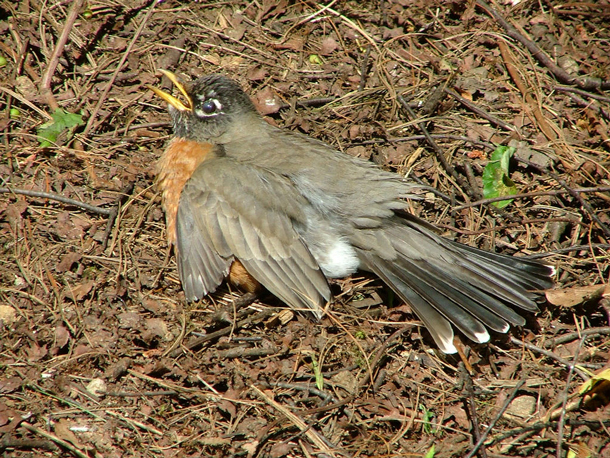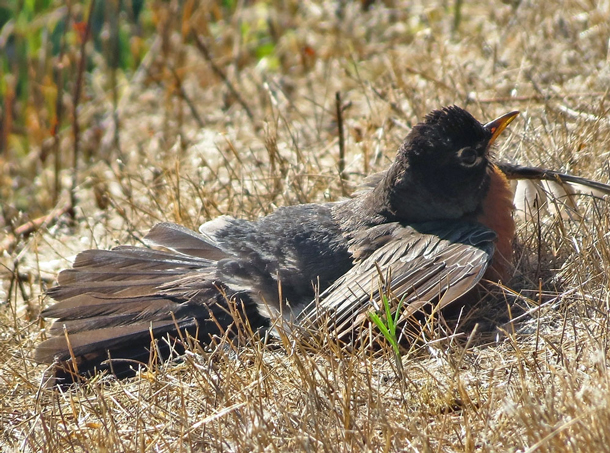BirdNote®: Do Birds Use Ants as Tools?
Air Date: Week of July 26, 2019

An American Robin spreads its wings and engages in “anting” behavior. (Photo: © John Dennehy)
Contrary to what the phrase “bird-brained” would have you believe, some birds are far smarter than you might expect. Take the common American Robin, which has learned to use an unusual tool for personal hygiene. BirdNote®’s Michael Stein has more about the behavior known as “anting”.
Transcript
BASCOMB: Now, guinea fowl have a reputation for being pretty dumb -- bird brained, you might say. But some birds are far smarter than you might expect. Take the common American Robin, which has learned to use an unusual tool for personal hygiene. BirdNote®’s Michael Stein has more.
BirdNote®
Do Birds Use Ants as Tools?
[American Robin song]
It’s a warm, sunny day, and we’re watching an American Robin, sitting on the ground, its wings outstretched and its tail splayed out behind it. If you look more closely, you might see something a bit shocking.
The robin is sitting on top of an anthill, and ants are swarming all over its body! You might even see the robin take an ant in its bill and wipe it underneath its wings.
So, what’s happening? Well, it’s kind of like an avian spa treatment.
[American Robin song]
Ornithologists call it “anting.” Although you might not see it too often, more than 250 species of birds have been recorded doing it. The purpose of anting remains something of a mystery, although most experts agree it has to do with transferring the ants’ secretions to the bird’s body. It’s likely that the ants’ formic acid helps the bird control feather-mites and other parasites. Some birds have been seen using citrus fruits, mothballs, and even glowing embers to achieve the same effects. One clever bird, a rook — the British cousin of the American Crow — even learned to strike a match, then touch the hot tip under its wing! * Talk about a hot spa treatment. [rook sound]
I’m Michael Stein.

Anting is a way for the American Robin and hundreds of other bird species to control feather mites and other parasites. (Photo: © Mike Hamilton)
Written by Bob Sundstrom
Producer: John Kessler
Managing Producer: Jason Saul
Editor: Ashley Ahearn
Associate Producer: Ellen Blackstone
Assistant Producer: Mark Bramhill
Narrator: Michael Stein
Bird sounds provided by The Macaulay Library at the Cornell Lab of Ornithology, Ithaca, New York. Recorded by G. A. Keller. Ambient recorded by C. Peterson.
BirdNote’s theme composed and played by Nancy Rumbel and John Kessler.
© 2019 Tune In to Nature.org June 2012 / July 2019 Narrator: Michael Stein
ID#063006AMROKPLU anting-01c
* Reference noted: Dennis, John V. Beyond the Bird Feeder. New York: Alfred A. Knopf, 1981. 1981:83
“Audubon's Original Notes on the Habits of the Wild Turkey Written for Charles Lucien Bonaparte” by A. W. Schorger. The Auk Vol. 79, No. 3 (Jul., 1962), pp. 444-452 (9 pages). DOI: 10.2307/4082826 https://www.jstor.org/stable/4082826
Morozov, Nicholai. (2015). Why do birds practice anting? Biology Bulletin Reviews. 5. 353-365. 10.1134/S2079086415040076. https://www.researchgate.net/publication/282623092_Why_do_birds_practice...
https://www.birdnote.org/show/do-birds-use-ants-tools
BASCOMB: For pictures, flit on over to our website, loe dot org.
Links
BirdNote®: “Do Birds Use Ants as Tools?”
Watch a video of an American Robin exhibiting “anting” behavior
Living on Earth wants to hear from you!
Living on Earth
62 Calef Highway, Suite 212
Lee, NH 03861
Telephone: 617-287-4121
E-mail: comments@loe.org
Newsletter [Click here]
Donate to Living on Earth!
Living on Earth is an independent media program and relies entirely on contributions from listeners and institutions supporting public service. Please donate now to preserve an independent environmental voice.
NewsletterLiving on Earth offers a weekly delivery of the show's rundown to your mailbox. Sign up for our newsletter today!
 Sailors For The Sea: Be the change you want to sea.
Sailors For The Sea: Be the change you want to sea.
 The Grantham Foundation for the Protection of the Environment: Committed to protecting and improving the health of the global environment.
The Grantham Foundation for the Protection of the Environment: Committed to protecting and improving the health of the global environment.
 Contribute to Living on Earth and receive, as our gift to you, an archival print of one of Mark Seth Lender's extraordinary wildlife photographs. Follow the link to see Mark's current collection of photographs.
Contribute to Living on Earth and receive, as our gift to you, an archival print of one of Mark Seth Lender's extraordinary wildlife photographs. Follow the link to see Mark's current collection of photographs.
 Buy a signed copy of Mark Seth Lender's book Smeagull the Seagull & support Living on Earth
Buy a signed copy of Mark Seth Lender's book Smeagull the Seagull & support Living on Earth

